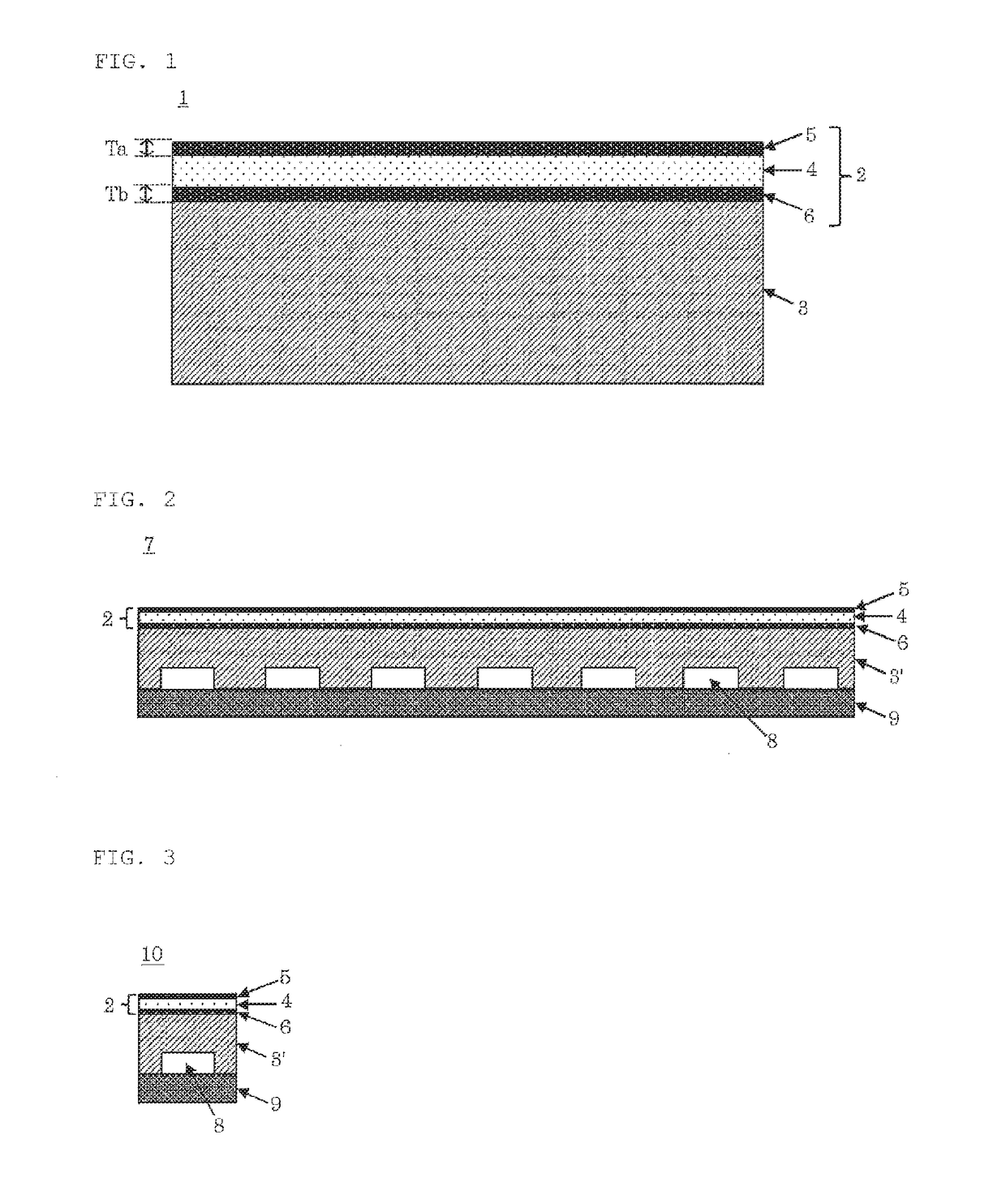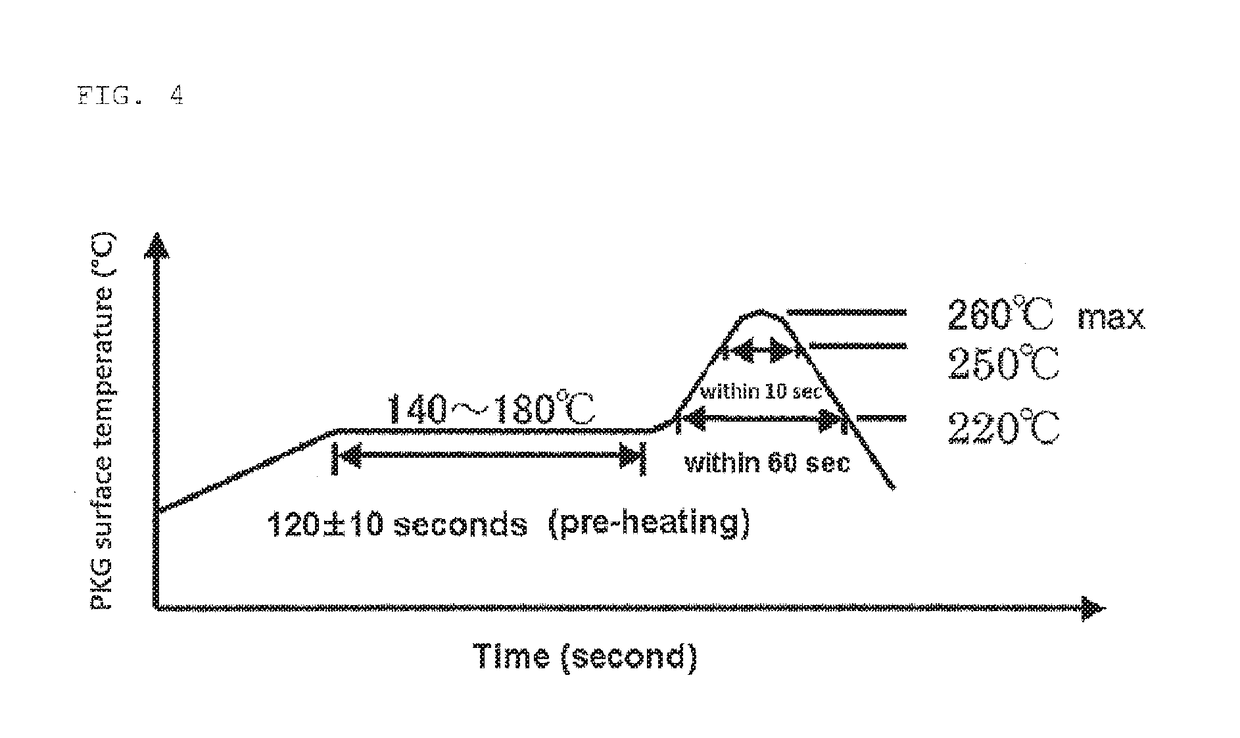Base-attached encapsulant for semiconductor encapsulation, method for manufacturing base-attached encapsulant for semiconductor encapsulation, and method for manufacturing semiconductor apparatus
a technology of base-attached encapsulants and semiconductors, which is applied in the field of encapsulants, can solve the problems of semiconductor devices being detached from the substrate, substrate or wafer warp, and large hindrance, and achieves excellent handling ability, low cost, and improved laser marking properties.
- Summary
- Abstract
- Description
- Claims
- Application Information
AI Technical Summary
Benefits of technology
Problems solved by technology
Method used
Image
Examples
example 1
Preparation of Resin Composition for Producing Base
[0147]Into 60 parts by mass of a cresol novolac type epoxy resin, 30 parts by mass of a phenol novolac resin, and 0.6 part by mass of a catalyst TPP (triphenylphosphine), 300 parts by mass of toluene was added. This was stirred and mixed to prepare a toluene dispersion of an epoxy resin composition.
[0148]To this toluene dispersion of an epoxy resin composition, E-glass cloth (manufactured by Nitto Boseki co., Ltd., thickness: 50 μm) as a fibrous base was dipped to impregnate the E-glass cloth with the toluene dispersion of the epoxy resin composition. The glass cloth was passed through a roll with the gap adjusted to 75 μm, and then left for 15 minutes at 120° C. to volatilize toluene. The glass cloth was subjected to heat molding at 175° C. for 5 minutes to obtain a molded article. This was subjected to heating at 180° C. for 4 hours (post cure) to cure the impregnated thermosetting resin composition, thereby obtaining an epoxy res...
example 2
Preparation of Resin Composition for Producing Base
[0153]Into 60 parts by mass of a cresol novolac type epoxy resin, 30 parts by mass of a phenol novolac resin, 3 parts by mass of titanium black as a black pigment, and 0.6 part by mass of a catalyst TPP, 300 parts by mass of toluene was added. This was stirred and mixed to prepare a toluene dispersion of an epoxy resin composition.
[0154]To this toluene dispersion of an epoxy resin composition, E-glass cloth (manufactured by Nitto Boseki co., Ltd., thickness: 50 m) as a fibrous base was dipped to impregnate the E-glass cloth with the toluene dispersion of the epoxy resin composition. The glass cloth was passed through a roll with the gap adjusted to 75 μm, and then left for 15 minutes at 120° C. to volatilize toluene. The glass cloth was subjected to heat molding at 175° C. for 5 minutes to obtain a molded article. This was subjected to heating at 180° C. for 4 hours (post cure) to cure the impregnated thermosetting resin composition...
example 3
Preparation of Resin Composition for Producing Base
[0159]Into 50 parts by mass of dimethylpolysiloxane both molecular terminals of which were blocked with vinyl groups as an organosilicon compound having a nonconjugated unsaturated bond, 50 parts by mass of dimethylpolysiloxane both molecular terminals of which were blocked with dimethylhydrogensiloxy groups, 0.2 part by mass of acetylene alcohol-based ethynylcyclohexanol as a reaction inhibitor, 0.1 part by mass of an octyl alcohol-modified solution of a chloroplatinic acid, and 3 parts by mass of carbon black as a black pigment, 200 parts by mass of toluene was added. This was stirred and mixed to prepare a toluene dispersion of a silicone resin composition.
[0160]To this toluene dispersion of a silicone resin composition, E-glass cloth (manufactured by Nitto Boseki co., Ltd., thickness: 50 μm) as a fibrous base was dipped to impregnate the E-glass cloth with the toluene dispersion of the silicone resin composition. The glass cloth...
PUM
| Property | Measurement | Unit |
|---|---|---|
| thickness Tb | aaaaa | aaaaa |
| diameter | aaaaa | aaaaa |
| diameter | aaaaa | aaaaa |
Abstract
Description
Claims
Application Information
 Login to View More
Login to View More - R&D
- Intellectual Property
- Life Sciences
- Materials
- Tech Scout
- Unparalleled Data Quality
- Higher Quality Content
- 60% Fewer Hallucinations
Browse by: Latest US Patents, China's latest patents, Technical Efficacy Thesaurus, Application Domain, Technology Topic, Popular Technical Reports.
© 2025 PatSnap. All rights reserved.Legal|Privacy policy|Modern Slavery Act Transparency Statement|Sitemap|About US| Contact US: help@patsnap.com



